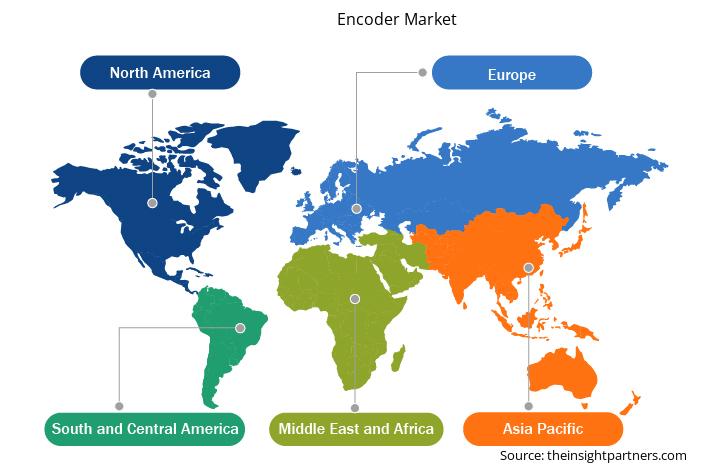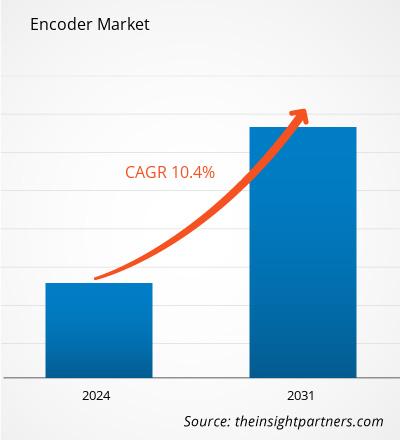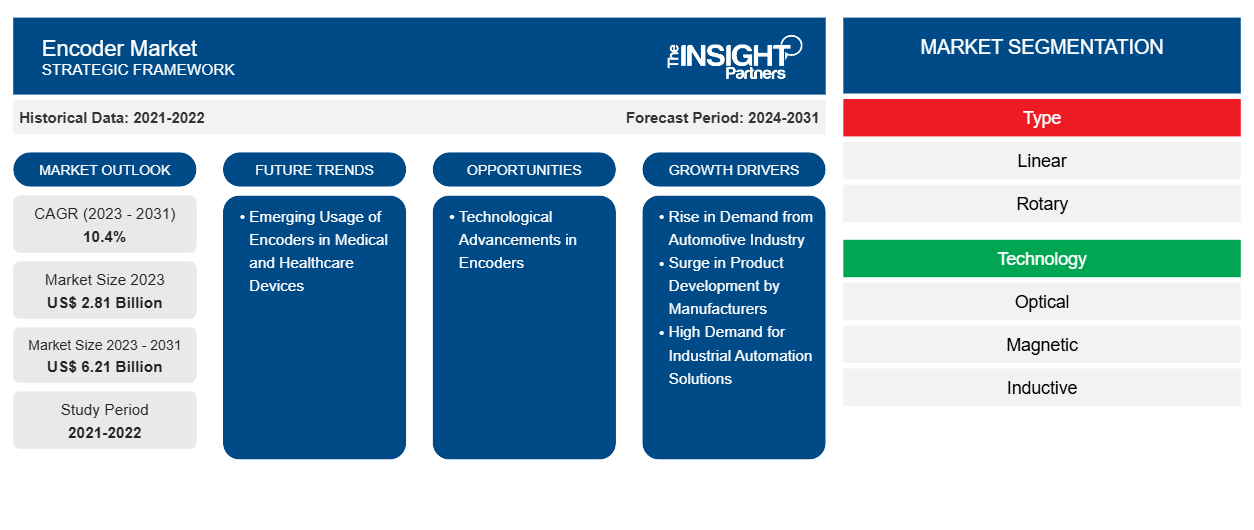Si prevede che la dimensione del mercato degli encoder raggiungerà i 6,21 miliardi di dollari entro il 2031, rispetto ai 2,81 miliardi di dollari del 2023. Si prevede che il mercato registrerà un CAGR del 10,4% nel periodo 2023-2031. L'uso emergente degli encoder nei dispositivi medici e sanitari porterà probabilmente nuove tendenze nel mercato nei prossimi anni.
Analisi di mercato degli encoder
L'aumento della domanda da parte dell'industria automobilistica; l'elevata domanda di soluzioni di automazione industriale tra piccole, medie e grandi imprese; e l'attenzione dei produttori sulla produzione di nuove auto sono alcuni dei fattori significativi che guidano il mercato degli encoder . Inoltre, l'aumento degli investimenti in soluzioni di robotica e automazione industriale aumenta la domanda globale di encoder. Inoltre, si prevede che il progresso tecnologico e l'integrazione di tecnologie avanzate come la tecnologia Internet of Things (IIoT) industriale, encoder ad alta velocità, sensori fotografici HD phased-array e un chip LED blu negli encoder che riducono i costi operativi creeranno opportunità di crescita del mercato durante il periodo di previsione. Inoltre, l'aumento della domanda di encoder personalizzati, l'attenzione dei produttori sullo sviluppo di mini encoder e un aumento delle attività di ricerca e sviluppo stanno spingendo il mercato degli encoder.
Panoramica del mercato degli encoder
Un encoder è un dispositivo che trasforma il movimento in un segnale elettrico che può essere letto da un dispositivo di controllo del movimento come un contatore o un PLC. Traduce le informazioni da un formato o codice a un altro, solitamente modificando il movimento fisico o la posizione in un segnale digitale. L'encoder invia un segnale di feedback che può essere utilizzato per calcolare posizione, velocità e direzione. Questa procedura è necessaria per mantenere uniformità, velocità e compressione in una varietà di applicazioni tecniche. Gli encoder svolgono un ruolo fondamentale nella traduzione dei movimenti meccanici in dati elettrici utilizzabili, necessari per un controllo e un'automazione accurati del sistema. Gli encoder sono componenti fondamentali della tecnologia moderna che garantiscono precisione e controllo in un'ampia gamma di applicazioni, tra cui macchinari industriali ed elettronica di consumo. Questo livello di precisione è essenziale per le attività che richiedono elevata accuratezza, come linee di assemblaggio e robot chirurgici. Gli encoder sono utilizzati in dispositivi elettronici di consumo come mouse e tastiere per tradurre le azioni dell'utente in segnali digitali che i computer possono gestire, migliorando così l'esperienza e il coinvolgimento dell'utente.
Personalizza questo report in base alle tue esigenze
Riceverai la personalizzazione gratuita di qualsiasi report, comprese parti di questo report, o analisi a livello nazionale, pacchetto dati Excel, oltre a usufruire di grandi offerte e sconti per start-up e università
-
Scopri le principali tendenze di mercato in questo rapporto.Questo campione GRATUITO includerà analisi di dati che spaziano dalle tendenze di mercato alle stime e alle previsioni.
Driver e opportunità del mercato degli encoder
Aumento della domanda nel settore automobilistico
Le auto sono sempre più dotate di una gamma di tecnologie avanzate e digitali per rendere la guida più sicura e confortevole per gli utenti. Gli encoder svolgono un ruolo importante nel settore automobilistico, migliorando la precisione, le prestazioni e la sicurezza di molti sistemi dei veicoli. Nelle auto moderne ed elettriche, gli encoder sono impiegati in una varietà di applicazioni, tra cui sistemi di servosterzo elettrico (EPS), sistemi di controllo motore, sistemi di frenata antibloccaggio (ABS), sistemi di controllo della trazione, controllo della posizione dei fari e sistemi di batterie, tra gli altri. Nei sistemi EPS, gli encoder sono utilizzati per monitorare la posizione del volante garantendo un controllo e una risposta esatti. Allo stesso modo, nei sistemi ABS e di controllo della trazione, gli encoder sono impiegati per rilevare e prevenire lo slittamento delle ruote, il che supporta il miglioramento della stabilità del veicolo. Ad esempio, secondo il Global Electric Vehicle Outlook 2024 annuale dell'Agenzia internazionale per l'energia (IEA), nel 2023 sono state vendute in tutto il mondo quasi 14 milioni di auto elettriche, ovvero 3,5 milioni in più rispetto al 2022, un aumento del 35% anno su anno; ciò porta il numero totale di auto sulle strade a 40 milioni. Questa crescita nel numero di auto mostra che la quota delle auto elettriche nel mercato automobilistico complessivo è salita al 18% nel 2023, rispetto al 14% del 2022. Le crescenti vendite di auto elettriche in tutto il mondo stimolano l'adozione di encoder tra i produttori di automobili per il controllo del motore nei veicoli elettrici e ibridi. Questi encoder forniscono un feedback esatto sulla velocità, posizione e direzione del motore, consentendo una migliore efficienza energetica e prestazioni migliorate. L'affidabilità e l'accuratezza del feedback fornito dagli encoder sono fondamentali per gli utenti e i produttori per migliorare la maneggevolezza del veicolo, soddisfare le normative di sicurezza e migliorare la tecnologia di guida autonoma. Inoltre, il progresso nel settore automobilistico e il crescente sviluppo nell'automazione e nell'elettrificazione aumentano la domanda di encoder ad alta precisione. Gli encoder ad alta precisione sono impiegati nei sistemi di guida autonoma come il cruise control adattivo, che utilizza la velocità e la posizione delle ruote per gestire accelerazione e frenata. Pertanto, la crescente domanda di circuiti integrati per encoder da parte del settore automobilistico guida il mercato degli encoder.
Progressi tecnologici negli encoder
La crescente domanda di automazione industriale, efficienza energetica e soluzioni sostenibili tra i settori sta aumentando la necessità di encoder tecnologicamente avanzati in tutto il mondo. L'integrazione di tecnologie avanzate come l'Internet of Things (IIoT) industriale e prodotti avanzati, tra cui encoder ad alta velocità, sensori fotografici phased-array HD e un chip LED blu, con gli encoder può fornire funzionalità di monitoraggio e controllo avanzate, che potrebbero ulteriormente abilitare la raccolta e l'analisi dei dati in tempo reale. Ad esempio, MELEXIS ha lanciato MLX90382, un IC encoder ad alta velocità per soluzioni di automazione industriale, robotica e mobilità. MLX90382 è un IC encoder magnetico assoluto integrato con un sensore di posizione magnetico monolitico. Combina un front-end magnetico Hall, un convertitore analogico-digitale, elaborazione del segnale digitale on-chip con latenza zero e driver di uscita multipli, rendendo il dispositivo adatto per applicazioni azionate da motori elettrici, come bracci robotici, macchine tessili industriali e macchine per imballaggio automatizzate. Le dimensioni ridotte, l'immunità ai campi disperdenti e il supporto per il rilevamento sia in asse che fuori asse dell'MLX90382 consentono un'integrazione fluida nei micromotori. Questi encoder sono progettati per soddisfare l'esigenza del settore di feedback ad alta velocità, essenziale per correggere il funzionamento e la sicurezza delle applicazioni azionate da motori elettrici.
Secondo i dati di Valin Corporation di dicembre 2022, IIoT offre vantaggi sostanziali agli encoder migliorando l'accessibilità, le prestazioni e l'affidabilità dei dati. IIoT offre monitoraggio in tempo reale e diagnostica remota, consentendo ai lavoratori di monitorare costantemente le condizioni e le prestazioni dell'encoder eliminando i tempi di inattività. Ad esempio, l'encoder Ethernet industriale Sendix di Kubler con un'interfaccia OPC UA integrata è altamente adatto per le applicazioni IIoT. È in grado di automatizzare la comunicazione indipendente dal controllo a una soluzione cloud o a un altro sistema di livello superiore. La configurazione dell'encoder tramite Internet consente la comunicazione tra sistemi ed elimina i guasti in modo rapido ed efficiente in caso di guasto. Ad esempio, gli encoder Ethernet industriali Kubler integrati con le interfacce Profinet, EtherCAT o EtherNet/IP supportano l'interfaccia OPC UA, aumentando così la versatilità e consentendo la trasmissione simultanea dei dati al controllo, al server Web o al cloud. L'integrazione degli encoder con i sistemi abilitati IIoT consente di raccogliere, elaborare e archiviare i dati provenienti da questi dispositivi su piattaforme basate su cloud, offrendo informazioni importanti sui modelli delle apparecchiature e sull'efficienza operativa.
Pertanto, si prevede che i progressi tecnologici negli encoder creeranno opportunità di crescita per il mercato degli encoder durante il periodo di previsione.
Analisi della segmentazione del rapporto di mercato degli encoder
I segmenti chiave che hanno contribuito alla derivazione dell'analisi di mercato degli encoder sono tipologia e tecnologia.
- In base al tipo, il mercato degli encoder è diviso in lineare e rotativo. Il segmento rotativo deteneva una quota maggiore del mercato nel 2023.
- In base alla tecnologia, il mercato degli encoder è segmentato in ottico, magnetico, induttivo e altri. Il segmento ottico ha detenuto la quota maggiore del mercato nel 2023.
Analisi della quota di mercato degli encoder per area geografica
L'ambito geografico del rapporto sul mercato degli encoder è suddiviso principalmente in cinque regioni: Nord America, Asia Pacifico, Europa, Medio Oriente e Africa, Sud e Centro America.
Il Nord America ha detenuto una quota di mercato significativa nel 2023. Stati Uniti, Canada e Messico sono tra le principali economie del Nord America. La regione contribuisce in modo notevole al mercato globale degli encoder grazie ai crescenti investimenti delle industrie verso l'adozione di robot. Ad esempio, secondo i dati della International Federation of Robotics (IFR) pubblicati nell'aprile 2024, le industrie negli Stati Uniti, in Canada e in Messico stanno investendo molto nell'adozione e nell'installazione di robot per l'automazione dei processi industriali. Automotive, elettrico, elettronico e manifatturiero sono le principali industrie che investono in modo significativo nelle tecnologie robotiche, aumentando la domanda di encoder per navigare la posizione, la velocità e il movimento delle parti robotiche.
Gli Stati Uniti sono il secondo produttore mondiale di automobili e veicoli leggeri dopo la Cina. Le vendite del mercato automobilistico negli Stati Uniti sono aumentate dell'1%, con un record di 14.678 robot installati nel 2023, che sono aumentati del 47% con 14.472 unità installate nel 2022. Nel 2023, i produttori di automobili e componenti rappresentano il 33% di tutte le implementazioni di robot industriali nel paese. Analogamente, nel 2023, le installazioni di robot in Canada sono aumentate del 43% a 4.616 unità. L'industria automobilistica ha rappresentato il 55% delle installazioni di robot del paese e le vendite del settore automobilistico sono aumentate del 99%, con 2.549 unità installate nel 2023. Inoltre, il numero di robot installati nell'industria manifatturiera messicana ha raggiunto le 5.868 unità nell'industria automobilistica nel 2023. L'industria automobilistica è il più grande utilizzatore di robot del paese, rappresentando il 69% delle installazioni totali in cui le vendite hanno totalizzato 4.068 unità nel 2023. La crescente espansione dell'industria automobilistica e la crescente installazione di robot hanno fatto aumentare l'adozione di encoder nelle linee di produzione automobilistiche. Gli encoder sono utilizzati nelle linee di produzione automobilistiche per mantenere una precisione costante, ridurre gli errori e garantire azioni ripetitive per i robot. I robot nell'industria automobilistica sono responsabili di compiti quali l'installazione di parti, l'applicazione di rivestimenti e complesse operazioni di saldatura. Gli encoder consentono ai robot di reagire in tempo reale a qualsiasi differenza di posizione ottimizzando l'efficienza e la qualità dei processi.
Approfondimenti regionali sul mercato degli encoder
Le tendenze regionali e i fattori che influenzano il mercato degli encoder durante il periodo di previsione sono stati ampiamente spiegati dagli analisti di Insight Partners. Questa sezione discute anche i segmenti e la geografia del mercato degli encoder in Nord America, Europa, Asia Pacifico, Medio Oriente e Africa e Sud e Centro America.

- Ottieni i dati specifici regionali per il mercato degli encoder
Ambito del rapporto di mercato degli encoder
| Attributo del report | Dettagli |
|---|---|
| Dimensioni del mercato nel 2023 | 2,81 miliardi di dollari USA |
| Dimensioni del mercato entro il 2031 | 6,21 miliardi di dollari USA |
| CAGR globale (2023-2031) | 10,4% |
| Dati storici | 2021-2022 |
| Periodo di previsione | 2024-2031 |
| Segmenti coperti |
Per tipo
|
| Regioni e Paesi coperti |
America del Nord
|
| Leader di mercato e profili aziendali chiave |
|
Densità dei player del mercato degli encoder: comprendere il suo impatto sulle dinamiche aziendali
Il mercato degli encoder sta crescendo rapidamente, spinto dalla crescente domanda degli utenti finali dovuta a fattori quali l'evoluzione delle preferenze dei consumatori, i progressi tecnologici e una maggiore consapevolezza dei vantaggi del prodotto. Con l'aumento della domanda, le aziende stanno ampliando le loro offerte, innovando per soddisfare le esigenze dei consumatori e capitalizzando sulle tendenze emergenti, il che alimenta ulteriormente la crescita del mercato.
La densità degli operatori di mercato si riferisce alla distribuzione di aziende o società che operano in un particolare mercato o settore. Indica quanti concorrenti (operatori di mercato) sono presenti in un dato spazio di mercato in relazione alle sue dimensioni o al valore di mercato totale.
Le principali aziende che operano nel mercato degli encoder sono:
- Asahi Kasei Microdispositivi Corp.
- Vishay Intertecnologia Inc.
- AG malato
- Honeywell International Inc
- Società ROHM Ltd.
- Allegro MicroSystems Inc
Disclaimer : le aziende elencate sopra non sono classificate secondo un ordine particolare.

- Ottieni una panoramica dei principali attori del mercato degli encoder
Notizie e sviluppi recenti sul mercato degli encoder
Il mercato degli encoder viene valutato raccogliendo dati qualitativi e quantitativi dopo la ricerca primaria e secondaria, che include importanti pubblicazioni aziendali, dati associativi e database. Di seguito sono elencati alcuni degli sviluppi nel mercato degli encoder:
- OMRON Automation, un importante fornitore di soluzioni avanzate di automazione industriale in India, mira a rafforzare la sua strategia aziendale incentrata su i-Belt, il servizio di soluzioni di co-creazione basato sui dati dell'azienda. Nota per il suo ampio portafoglio che comprende sensori intelligenti, robot, visione, sicurezza delle macchine, PLC, servocomandi e azionamenti, OMRON è pronta ad arricchire ulteriormente la sua gamma di soluzioni end-to-end integrandosi con il servizio basato sui dati i-Belt. (Fonte: OMRON, comunicato stampa, agosto 2023)
- Microchip Technology Inc. ha annunciato un'iniziativa pluriennale di oltre 300 milioni di dollari USA per espandere la sua presenza in India. Attraverso questo investimento, l'azienda mira a stabilire centri di ricerca sui semiconduttori, progettazione di chip e ingegneria delle apparecchiature nel paese. Nello stesso mese, Microchip Technology Inc. ha inaugurato un centro di ricerca e sviluppo a Hyderabad. Secondo l'azienda, è probabile che il mercato dei semiconduttori in India raggiunga i 64 miliardi di dollari USA entro il 2026, rispetto ai 22,7 miliardi di dollari USA del 2019. (Fonte: Microchip Technology Inc., comunicato stampa, luglio 2024)
Copertura e risultati del rapporto sul mercato degli encoder
Il rapporto "Dimensioni e previsioni del mercato degli encoder (2021-2031)" fornisce un'analisi dettagliata del mercato che copre le seguenti aree:
- Dimensioni e previsioni del mercato degli encoder a livello globale, regionale e nazionale per tutti i principali segmenti di mercato coperti dall'ambito
- Tendenze del mercato degli encoder, nonché dinamiche di mercato quali driver, vincoli e opportunità chiave
- Analisi PEST e SWOT dettagliate
- Analisi di mercato degli encoder che copre le principali tendenze del mercato, il quadro globale e regionale, i principali attori, le normative e i recenti sviluppi del mercato
- Analisi del panorama industriale e della concorrenza che copre la concentrazione del mercato, l'analisi della mappa di calore, i principali attori e gli sviluppi recenti per il mercato degli encoder
- Profili aziendali dettagliati
- Analisi storica (2 anni), anno base, previsione (7 anni) con CAGR
- Analisi PEST e SWOT
- Valore/volume delle dimensioni del mercato - Globale, Regionale, Nazionale
- Industria e panorama competitivo
- Set di dati Excel
Report recenti
Testimonianze
Motivo dell'acquisto
- Processo decisionale informato
- Comprensione delle dinamiche di mercato
- Analisi competitiva
- Analisi dei clienti
- Previsioni di mercato
- Mitigazione del rischio
- Pianificazione strategica
- Giustificazione degli investimenti
- Identificazione dei mercati emergenti
- Miglioramento delle strategie di marketing
- Aumento dell'efficienza operativa
- Allineamento alle tendenze normative























 Ottieni un campione gratuito per - Mercato degli encoder
Ottieni un campione gratuito per - Mercato degli encoder